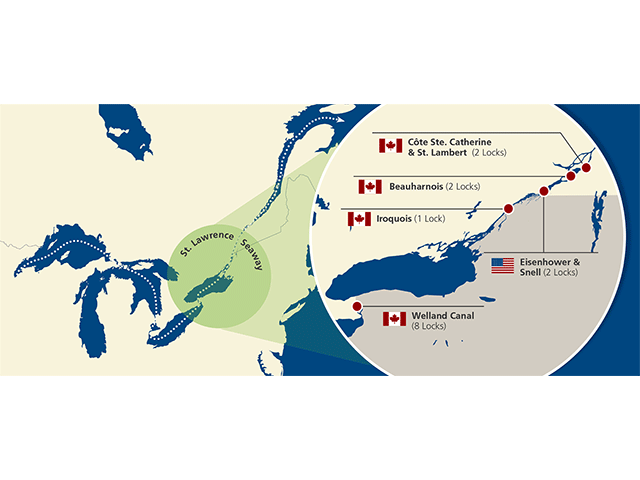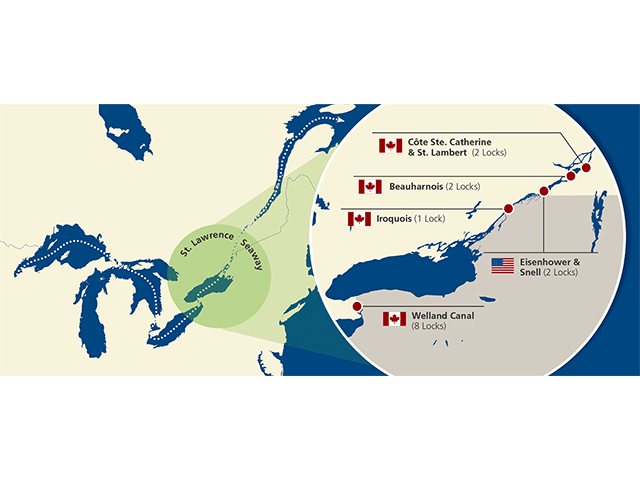Market Matters Blog
St. Lawrence Seaway Strike Ends as Tentative Agreement Reached
After a seven-day strike, Unifor announced Oct. 29 evening that it reached a tentative agreement with St. Lawrence Seaway Management Corporation (SLSMC) during mediated negotiations on behalf of Ontario and Quebec members engaged in strike action since Oct. 22.
The tentative agreement covers Unifor members at Locals 4211, 4212 and 4323 in Ontario and Locals 4319 and 4320 in Quebec who work in the supervisory and engineering group and the maintenance, operations and clerical group, noted the press release from Unifor.
The Unifor striking workers were from the 13 Canadian locks, but not the two U.S.-based locks. Given that all the locks operate as a single system, any closure suspends operations of the entire system as happened the past seven days. This was the first strike-related, midseason closure of the St. Lawrence Seaway since June 1968.
Details of the tentative agreement will first be shared with members and made public once an agreement is ratified. A vote will be scheduled in the coming days.
"Many industries in Canada remained hopeful that weekend negotiations proved fruitful, with a combination of financial losses and losses to Canada's reputation as a reliable place to conduct business at stake," said Cliff Jamieson Canadian Grains Analyst. "While the Canadian Chamber of Commerce has stated that the strike would cost the Canadian economy $34 million per day, the Chamber of Marine Commerce reports that the Canadian/U.S. losses will range from $50 to $80 million per day USD, or close to $100 million CAD."
"The Canadian government is facing pressure due to inconsistent actions in the past and a lack of consistency in the application of Labor Code rules. Earlier this year, a two-week West Coast dockworkers strike again placed the government on a tightrope between catering to business and economic activity and the rights of workers to strike. The strike lasted 15 days, with the union rejecting two mediated settlements prior to reaching agreement, resulting in the disruption of $10 billion CAD in trade, as estimated by the Vancouver Board of Trade," said Jamieson.
P[L1] D[0x0] M[300x250] OOP[F] ADUNIT[] T[]
"Bulk grain movement through licensed terminals was not affected during the West Coast strike, as Clause 87.7 of the Canada Labor Code requires that workers must continue to provide services to 'ensure the tie-up, let-go and loading of grain vessels at licensed terminal and transfer elevators, and the movement of the grain vessels in and out of a port.' This clause should have also applied in the current seaway strike; the St. Lawrence Seaway Management Corporation is seeking a ruling on this issue with no response to date."
On Oct. 27, Soy Canada released a statement to government ministers indicating the seaway is a mode of transportation for 10 million metric tons of grain. "We urge you to take all necessary steps to quickly bring about an agreement between the two parties and ensure this strike is ended to prevent further damage to the grain sector, further disruptions to the food supply of our customers and to prevent further damage to the wider Canadian economy."
Fertilizer Canada released statements Oct. 27 and Oct 28. The most recent states "In July during the West Coast Ports strike, Minister O'Regan invoked Section 105.2 and Section 107 to bring a resolution to the labor dispute. These, along with all other tools under the Canada Labor Code, must be considered and actioned as soon as possible to bring a swift end to the strike."
As mentioned above, this strike impacted the entire Seaway system, which includes the U.S. Port of Duluth-Superior at the far end of the Seaway. Jayson Hron, director of communication and marketing Duluth Seaway Port Authority, told DTN on Oct. 23 "As a result of the strike, multiple ships loaded with exports are presently unable to exit the Great Lakes-St. Lawrence Seaway System and a growing queue of inbound ships are unable to enter or pass through specific segments. One vessel presently loading wheat in Duluth is scheduled to deliver its cargo to Algeria upon departure through the now-shuttered Seaway. Several subsequent ships are scheduled to arrive in Duluth-Superior via the Seaway for grain in the coming weeks. Various other vessels are scheduled to arrive with imports to support regional manufacturing."
Mike Steenhoek, executive director of Soy Transportation Coalition, told DTN in an Oct. 23 email, "We encourage a quick resolution to the negotiations between the two parties. During this time in which U.S. agriculture has a number of supply chain challenges (low water on the Mississippi River, for example), it is imperative to have other supply chain options available for farmers. The Great Lakes/St. Lawrence Seaway has the potential to increase its share of U.S. agricultural exports, but it must demonstrate it can be a reliable option. The current strike calls this reliability into question."
Michael Folsom, Seaway Ship Watchers Network, Clayton, New York, told DTN that "The news of an agreement between Unifor and SLSMC was crucial in order to put a stop to the economic disaster that was brewing. The workers and employers have hopefully found reasonable common ground to allow for progression in the industry, rather than further setbacks. It is imperative that all parties and stakeholders work together now to get ships and cargo moving again, especially with just eight to nine weeks of the Seaway season remaining.
"By the end of Sunday, it's expected that 55 ships will be anchored between Lake Erie and Sorel, Quebec awaiting Seaway access. That number is more than doubled when factoring in ships at ports including the US Navy's USS Marinette in Cleveland and the French cruise ship Le Dumont-D'Urville in Toronto."
Folsom added that "Word is navigation will resume as early as 7 a.m. on Monday, Oct. 30. Lock passage is expected to become available soon after. Pilot assignments are being made and ship turn-of-order is to be confirmed. Expect a lot of ship traffic over the next several weeks as the Seaway season winds down.
"This strike, a first in 55 years on the Seaway, brought much-needed attention to the importance of this waterway and the effects it has on North American commerce. Too often the St. Lawrence River and Great Lakes are overlooked or forgotten; let's use this spotlight to enhance its reputation both close to home and abroad."
Link to Great Lakes Seaway: https://greatlakes-seaway.com/…
Link to Unifor press release: https://www.unifor.org/…
Link to Seaway Ship Watchers Network: https://theshipwatchers.wordpress.com/…
Mary Kennedy can be reached at Mary.Kennedy@dtn.com
Follow her on X, formerly Twitter, @MaryCKenn
(c) Copyright 2023 DTN, LLC. All rights reserved.





Comments
To comment, please Log In or Join our Community .